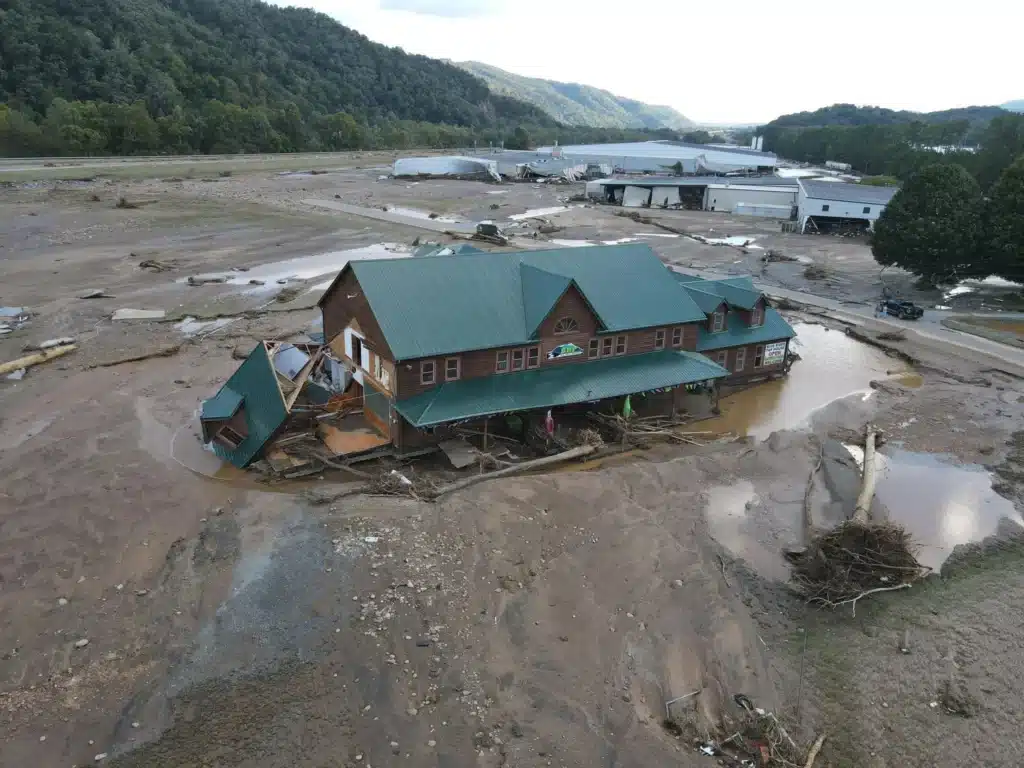
Blue Ridge Paddling after hurricane Helene. Photo courtesy of Blue Ridge Paddling.
Media members of OWAA touring the new home of Blue Ridge Paddling in July of 2024 were duly impressed. The recently-completed, lodge-like building in Erwin, Tennessee was bright, airy and full of light. There was ample space for retail. Boats, paddles, throw bags, personal flotation devices and branded merch covered the racks and shelves.
The building included the Blue Ridge Taphouse which served up an array of beverages, presented multiple TVs, and had a patio filled with yard games like corn hole, ladder-ball and giant jenga. You could see the Nolichucky River running peacefully by, just a few hundred yards away. For an outdoorsperson taking it all in, it really was a beautiful thing.
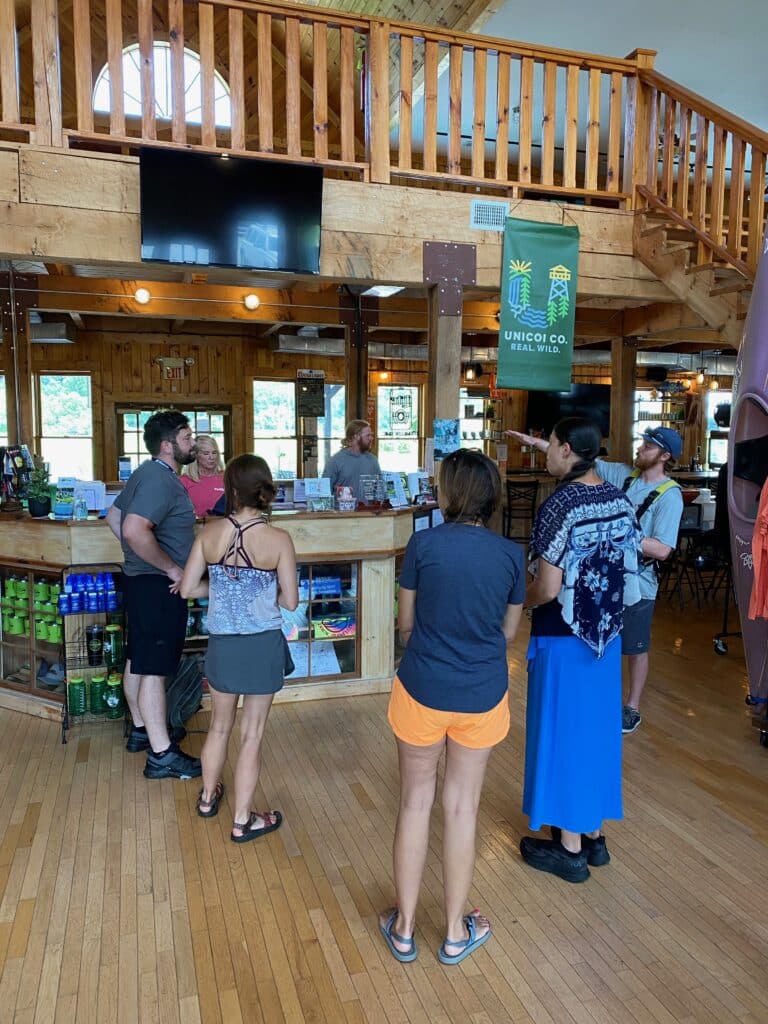
OWAA members tour Blue Ridge Paddling in 2024.
But the night of Friday, September 27, 2024, Hurricane Helene arrived, having worked its way up from the Gulf Shore the day prior. As the rains fell, the waters ran down the ridges, consolidated in mountain streams and started feeding the rivers. Throughout the region, the rivers started to rise.
Before Helene
For companies large and small, the outdoors is big business here.
Steven Foy, the Director of Outpost Operations at the Nantahala Outdoor Center (NOC) noted that just for rafting alone, they would see about 105,000 clients per year. And 2024 was on track to just about hit that, perhaps topping 108,000. After years of planning, Foy and his colleagues at NOC were especially excited as they prepared to open some new lodging units on their property, bungalow-style cabins with kitchens, private decks and king bedrooms.
On the other end of the business spectrum, Blue Ridge Paddling was just starting to get traction. Founded by two brothers in 2022, they saw their first full season in 2024 and with a focus on taking smaller, more intimate groups rafting, they catered to nearly 600 clients in 2025.
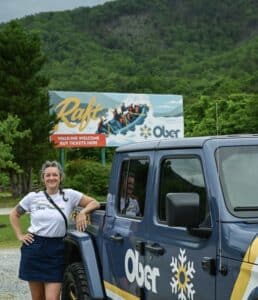
“We were finally getting into our groove,” said co-owner Mason Schmidt. “As most people know, as a small business, if you can get through your first three years, your chances of survival are much better. We were finally able to take a deep breath and realize we’d made a good decision and were growing at a good pace. We were just so close to breaking through…”
Uncle Johnny’s Nolichucky Hostel, Cabins & Camping is located just about forty feet from the Appalachian Trail (AT). Originally built in 1998, the previous owner of Uncle Johnnys battled a long illness, to which he succumbed, passing away in 2018. Having thru-hiked the AT in 2021, Terry Wise came in, bought the neglected property and then spent two and a half years fixing it up.
He said, “The work on the hostel was really coming along. I felt good about it. I was resolved that I was going to spend the rest of my life putting band aids on it, fixing the electrical, the plumbing, a warped floor and what have you, but it was coming along.”
The Projects & Attractions Director and Whitewater Director at Ober Mountain Adventure Park and Ski Area, Lacy Bramlett has also guided on the Pigeon River since 2010. As a boater, she always watches the weather as it comes toward them. Bramlett went rafting twice the day before, on Thursday the 26th.
“There were some big water flows at 4,000 and 10,000 CFS [cubic feet per second] but it was odd to have a big water event in September after drought conditions through the summer. I usually like to see water coming in. But as I started looking at the maps, it raised a red flag as the system became stationary.”
Helene had a herald in that a predecessor rain (which happens 24-36 hours ahead of a tropical storm) already dropped 6-12 inches of precipitation in the mountains – and the hurricane hadn’t even arrived yet.
Anna Rawlins is the Chief Marketing Officer at Eagles Nest Outfitters, Inc (ENO) in Asheville, North Carolina. “We were at work the day before. We saw that there was going to be some normal flooding. We brought our laptops home in case we had to work from home ‘for a few days’ and then the next day we were texting before the cell towers went out. We just kept telling everyone to stay safe.” She was worried about missing ENO’s 25th Anniversary party, which was scheduled for that Saturday.
As rafting company owners, Schmidt and his brother are always watching the weather and the conditions of the rivers. Having received a surprising amount of rain that week, the Nolichuky was already up around 25-30,000 CFS and Helene hadn’t even arrived yet.
He said, “We knew it was going to get high, but we had no idea just how high.”
Helene hits
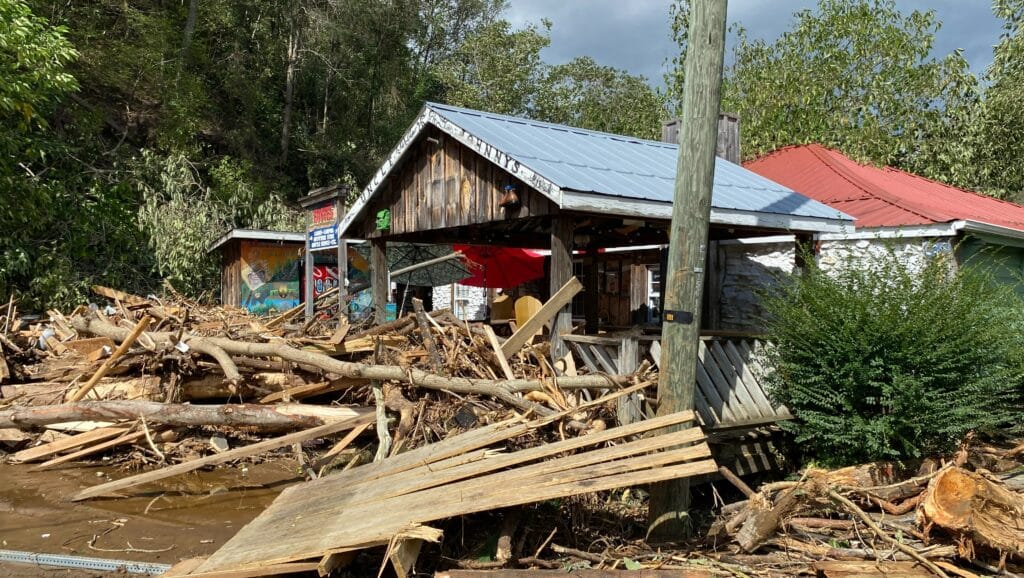
Uncle Johnny’s Nolichucky Hostel after hurricane Helene. Photo courtesy of Uncle Johnny’s Nolichucky Hostel.
Schmidt was on the Blue Ridge Paddling property on Friday morning. “We went out to look at the river and saw it was coming up even more, like 50-60,000 CFS. We started to see spaces in the floodplain filling with water. Then we knew that this was something we’d never seen before. We sort of went into shock.”
Luckily a friend came by and encouraged the Schmidt brothers to start loading up everything they could. They grabbed rafts and whatever they could carry from their boat barn, threw it all onto trailers and hitched them to their vehicles. Schmidt, who was living on the property, barely had time to grab his laptop, a cell phone and a charger. They drove the vehicles to a ‘safe space’ in front of the boat barn, but then noticed water around the tires. So they moved the vehicles again, this time across the street. About 40 minutes later, they saw four to five feet of water in their buildings and again water was lapping the tires of their vehicles. They then drove the vehicles higher, to the local high school which was now being used as an emergency shelter.
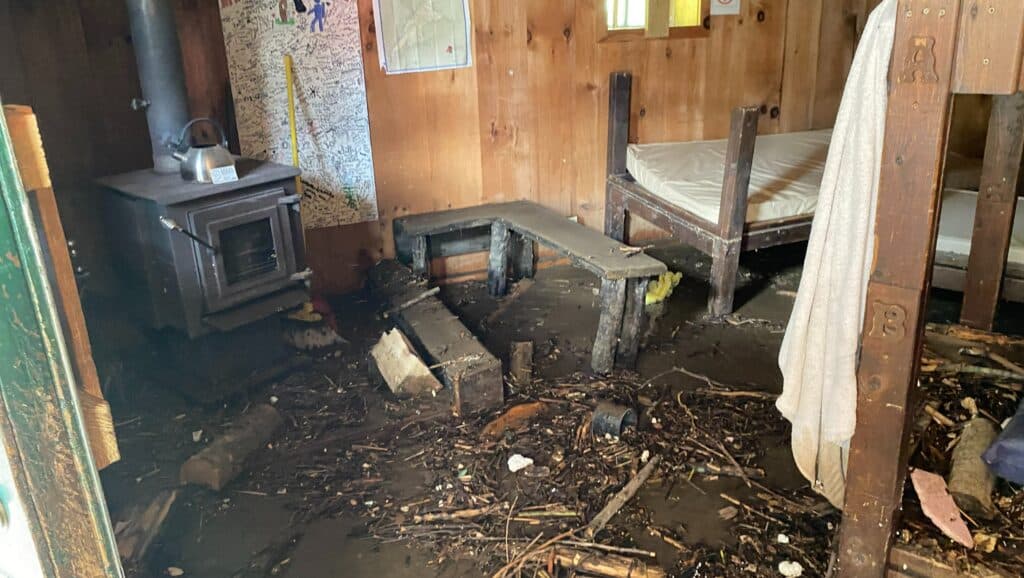
Inside Uncle Johnny’s Nolichucky Hostel after hurricane Helene. Photo courtesy of Uncle Johnny’s Nolichucky Hostel.
“That’s when it sunk in that we’d just lost everything that we’d put our lives into. It wasn’t like when a river rises and you can predict it. It just happened so darn fast.”
During the night of the 27th, the flow of the Pigeon River accelerated, speeding up and building in volume all night long, reaching an astounding 98,000 CFS – until the gauge stopped working.
The Schmidt brothers didn’t sleep at all that night and were back on property at about six A.M.
“We showed up to the site [of the business] and it was a scene that we’ll never, ever forget. It was a total apocalyptic zone. There was nothing. No road. The boat barn was completely gone. A quarter of the main building had been ripped off and was 100 yards downstream.”
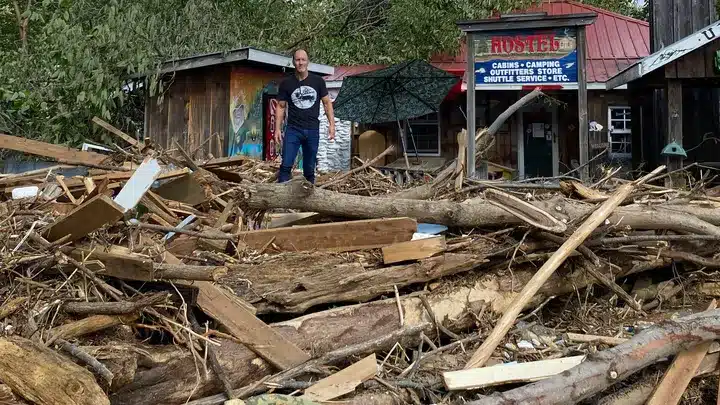
Uncle Johnny’s Nolichucky Hostel after hurricane Helene. Photo courtesy of Uncle Johnny’s Nolichucky Hostel.
With their mother, the two brothers walked as near to their property as they could and just cried.
Bramlett went out and got coffee about 8:30 A.M. She wanted to see what the flooding was going to be like but saw that her town of Hartford, Tennessee was already under water. As she watched a shipping container float by, she realized she just had to get out of there. She grabbed her cat and went west to a hotel in Newport, Tennessee.
“While I was there, I heard that the dam broke. It turns out that wasn’t true but I didn’t know that at the time. Just in case, I immediately left and went to Morristown so that I wasn’t stuck in that situation [in Newport]. The river peaked at about eight or nine that evening, I just assumed that my belongings were gone, that my town was gone.”
“We started making our way back the next day, but topographically things had changed, between the landslides and the tree debris that came down the river. Once we got downtown, we saw that two or three feet of water was still in the cafe and the BP had at one point had water up to its ceiling, at about ten or twelve feet. We went to find friends and check on them. I mean, day one was just mind blowing, like, ‘What happened here?!?!’ Day two was boots on the ground and people responding. I was very happy and proud to be a river guide right then, as in those moments you saw our community come together.”
Rawlins’ home has a well. With the electricity out, the pump couldn’t work and so she had no water. But as an outdoors person, Rawlins pulled out water filters, propane stoves and other gear and started teaching her neighbors how to use them. They then simply fetched buckets full of creek water to flush their toilets as some families rationed their use, flushing just once per day.
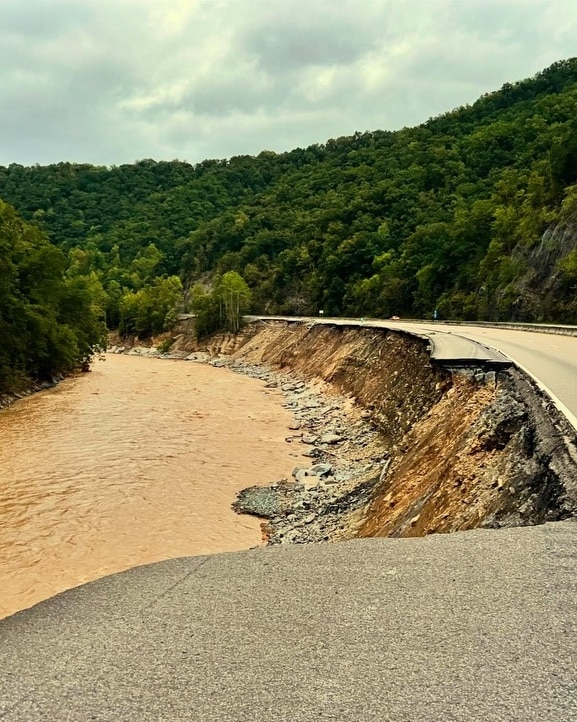
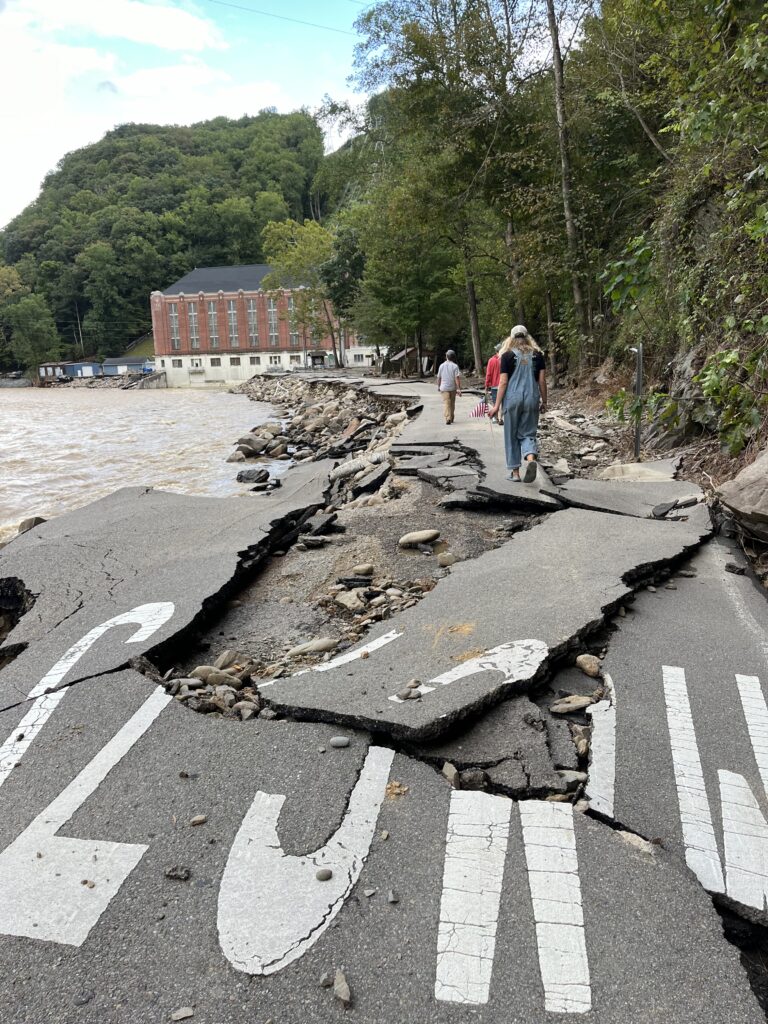
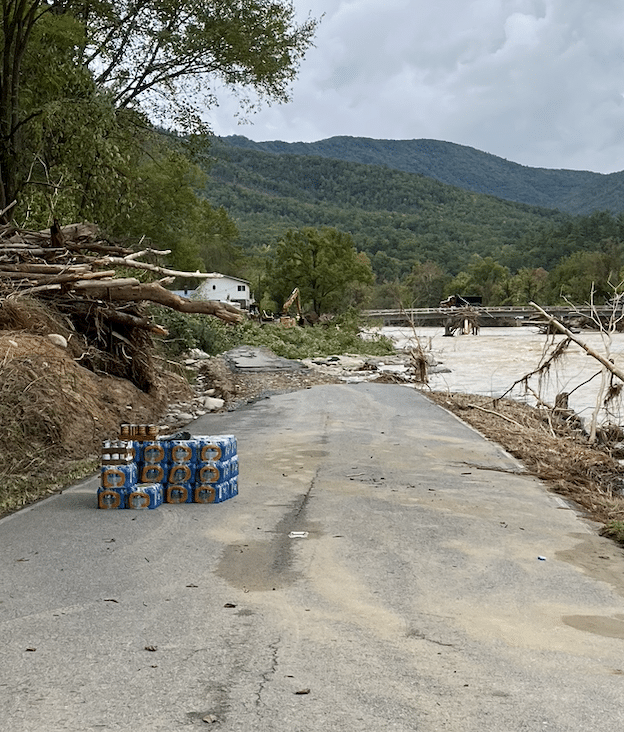
The day after the flood, residents take stock of what’s left of their town – and find some provisions that had been dropped for residents on Trail Hollow Rd before the road was made accessible again for car traffic. Photos courtesy Lacy Bramlett.
“We turned to our neighbors and were all talking to each other, not having an idea of the scale of the thing. We wondered, ‘Are we the only ones without power?’ Our daily routine was checking in on everyone. We tried going to downtown Mars Hill and everyone was walking around, all the gas stations and groceries all shut down. There was no communication. No one knew what was happening.”
In situations like this, with the skills and equipment the outdoor community has, they can provide a certain level of additional disaster assistance, almost de facto emergency responders.
Noah Wilson is the Director of Sector Development for the Asheville-based incubator, Mountain BizWorks: “In the midst of all that devastation, there was a bigger recognition that our outdoor community can be a key lifeline. It was the outdoors community who supplied people that knew how to do complex chainsaw work. The white water guides became swiftwater rescue (or recovery) crews. We had people who stood up and said, “Hey, I’m a ‘Woofer’ [Wilderness First Responder], I can help!”
Volunteers started backpacking supplies and insulin up to ten miles to get necessary items to isolated homes that couldn’t be reached any other way. Outside Asheville, ATV rental companies just loaned out their vehicles so that people could distribute aid to isolated mountain communities. Ober Mountain opened up its resort for displaced people to stay. Rawlins’ company, ENO, made sure to continue to pay their employees while shuttling supplies out to them and tracking how everyone was doing. On a broader scale, the Outdoor Business Alliance stepped up with micro grants and funding to small brands in the area, primarily to help keep employees paid.
Eventually Rawlins made her way to downtown Asheville. “There were posted flyers (on paper mind you) from aid groups and various community meetings all over. There were people with solar chargers in parking lots letting people charge up. It was beautiful to see everyone come together but also devastating.”
“The hardest day was the day we got cell service back because then we could see the true breadth of everything. By then our days were all about unloading semi-trucks of water, food, and toilet paper by hand with people of all backgrounds working side by side. Everything was day-to-day, just surviving and helping other people.”
She credits the outdoor community in Asheville with their response as, once she got cell service back, she had messages from people with tractors, chainsaws and other resources.
She said, “I honestly think if this had happened in another city, the response would have been much, much worse. It’s a unique place because there are so many outdoors people and jack-of-all-trades who have equipment and are uniquely qualified for a situation like this.”

A photo with friends on a pew that had washed down from upstream and landed in the public river access area in Hartford, Tennessee. Photo courtesy of Lacy Bramlett.
At Uncle Johnny’s, Wise saw almost all of his work undone. “The hurricane pretty much negated everything I’d done over those two and a half years. Everything was either full of mud, wiped away or had tree branches through the roof.”
He estimates that debris washed up and covered over 60% of his property. Some buildings on higher ground, like the bathhouse and some cabins, survived while the store, hostel and several other cabins were completely destroyed.
Schmidt and his brother sat tight for the first few days, allowing crews to do their work to find and recover bodies and as the remains of their own property was checked several times by local fire and rescue. After about a week, they posted on Facebook to see if they could get some help removing the more than four feet of mud, sand and wet sludge that had impacted itself throughout what remained of their building. Some forty friends showed up, so the brothers bought as many shovels and they all spent the next two weeks cleaning out the building, taking the walls down to the studs. They even had to contend with some looters who a neighbor spotted one night. After that, they were sure to remove everything of any value that was still left in the building.
In Asheville, it took four days to get power back. It would be another month for the water to come back on. Further, in the midst of this exceptionally stressful time, all of these outdoors people were suddenly bereft of their favorite activities.
“That was the other challenge at that point,” Rawlins added. “So many of us go outside as therapy but then the trails and parks were all shut down. So they were no longer the places for respite that they once were, instead they were just devastated.”
While so many lost their solitude and their connectivity to nature, others lost their livelihoods entirely. One campground owner told the Mountain BizWorks team, “I have no way of being in business right now. I had a campground on the river. But now I can’t get people to the campground, the campground itself is an absolute mess and we can’t take people on the river. We don’t know how we can operate.”
The Aftermath
In the months since the storm hit, Foy said, “It’s amazing to see the amount of progress and improvements and recovery but it’s still just immense in terms of the work that still needs to be done.”
NOC has been at reduced capacity but is still booking as much business as it can, including legacy youth groups that come every year. He says it’s still too early to get a pulse on what overall tourism demand is going to be like.
He added, “We were really unsure until about a few months ago if the French Broad and Pigeon Rivers would even have access points.”
The U.S. Forest Service generously allowed them to do a scouting trip along with American Whitewater. “When we went on the French Broad River we were overjoyed to see the river had stayed in the same condition. There was lots of debris but nothing of major concern. The run is the same, although the aesthetic value has changed. Now, the Pigeon is a different story. It runs along I-40. When that highway got washed out, much of it went into the river so now it’s a different run, a different river entirely. Further the take-out was damaged. Worst of all, we not only lost the put-in, we lost the entire road TO the put-in.”
He continued, “There are plenty of outdoor resources that won’t be able to open for this season and that’s heartbreaking. I mean, there are still places where there’s no difference between the road and the riverbed. Some Nolichucky businesses have no confidence in being able to open this year and taking a year off means you’re unstable for up to three seasons after that. There are still resources that won’t be able to support tourism and that’s gut wrenching.”
Schmidt’s business is a case in point. While their first GoFundMe quickly raised $55,000 and they were able to get grants from local nonprofits Rise Erwin and Region AHEAD for $20,000 and $25,000 respectively, the damage was in excess of $2,000,000. He mentioned that they got no assistance from the Federal Emergency Management Agency (FEMA) and that it was impossible to take out any loans, since they were already in debt as a new, small business.
Yet Foy is effusive in his praise for the agencies that stepped up to support initial recovery efforts. He quickly rattled off how helpful and responsive Duke Energy and the North Carolina Department of Transportation were while FEMA and then Tennessee Emergency Management Agency got to work removing debris.
He praises work by the staff members of Senator Marsha Blackburn, Senator Ted Budd, Senator Thom Tillis, Congressman Chuck Edwards and Congresswoman Diana Harshbarger and credits their teams for being instrumental in advocating for supplemental relief funding, which was passed by the 118th Congress. Although the approval process was relatively quick, the funds weren’t confirmed until December and only came through in early 2025. Further, the states wouldn’t release their own emergency funds until the federal funds came through, so speedy implementation was crucial.
The Tennessee Department of Tourist Development then launched a campaign to promote recreation on their rivers while the state outdoor recreation offices for both North Carolina and Tennessee were, in his words, “Critical in their response in getting infrastructure back on line and getting the right people to be at the table together.”
The Future
If you go to the website of Blue Ridge Paddling now, you’ll see a photo of their devastated headquarters building. Other parts of the site bely a better time, before Helene. The page for their taphouse shows a bright, sunny bar filled with people enjoying beverages and still asks you to, “Come enjoy a cold beverage poured in a frosted glass and share your river stories!”
The Schmidt brothers were eventually able to secure some $515,000 from the Governor’s Response and Recovery Fund, which they’re using to develop architectural drawings and engineering plans to rebuild. They’re focused on getting their building back up and running and reopening the taphouse by the new year. They hope to start rafting again in the spring of 2026.
The GoFundMe site for Uncle Johnny’s Nolichucky Hostel has raised more than $25,000 toward a $45,000 goal. The page is also full of images of the destruction that Helene wrought upon this business.
While he noted deep appreciation for the donations received, which came from local organizations, national organizations like Samaritan’s Purse, and individuals, he said it’s still a fraction of what he needs to rebuild his passion project.
“The longer term goal is about rebuilding and the longest term goal is getting back to the place we were before the storm – thriving,” noted Rawlins passionately. “But a lot of the brands and companies here right now are still in that initial phase. If you lost a building, the insurance hasn’t come through yet. Or you’re paying a mortgage and for repairs, but you have no revenue. So much of that land that was buildable and flat by the river just isn’t there anymore. A lot of the day to day isn’t totally focused on the long term planning yet, but we’re getting there.”
While the scars to the landscape and structures are still very obvious, there are unseen emotional scars that will linger on as well. One local official said that she still can’t talk about Helene without bursting into tears and openly shared that she’s suffering from Post Traumatic Stress Disorder from it.
Foy said, “It’s been months since the storm hit. It’s amazing to see the amount of progress and improvements and recovery but it’s still just immense in terms of the work that still needs to be done. Still, we’re feeling better than a month ago and a month ago we were feeling better than the month before that. We completed guide training, have been hiring and are just feeling good about operating this season, albeit in limited capacity.”
“We pride ourselves on the outdoors and try to be a tourism town,” said Wise. While the rafting industry has been devastated, it will come back and it will survive. The hikers will keep coming down the trail. I’ll be okay this year.”
He paused, then added, “To this day it’s remarkable to look up and down the river and it just looks so different from even several months ago. It’s hard to convey the force that ran through there for a day and a half that affected millions of people. But there is recovery and optimism here. The whole town wants people to not be afraid, to come out, enjoy the outdoors and pump money into the economy.”
But while some areas were deeply affected by the storm, many were virtually untouched and still ready to welcome outdoors people to come recreate. Other areas are recovering quickly.
Schmidt is optimistic. “Yes, we will come back. And we’ll build back stronger than what it was before. But it will take time, comebacks take time. There are now plans in the works to redesign the entire Nolichucky River Corridor, to add parks and more parking lots and better access and better community spaces. We have a blank slate and people are working to create some really cool stuff here.”
“The next step now is to convince people to come back,” said Foy. “We certainly have the capacity and if folks want to come here and go rafting, we sure can take ‘em, I tell you what.”
